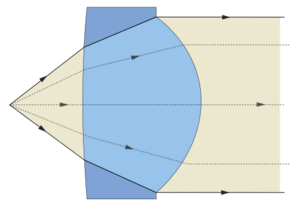Collimated light facts for kids
Collimated light is a special kind of light where all its rays travel in a very parallel way. Imagine many tiny arrows of light all pointing in the exact same direction. Because the rays are parallel, this light spreads out very slowly as it travels.
In a perfect world, collimated light would never spread out, no matter how far it went. However, in reality, even the best collimated light will spread a tiny bit over long distances. This happens because of something called diffraction. Diffraction makes it impossible for scientists to create a perfectly collimated beam that never spreads.
You can make light roughly collimated using a device called a collimator. This device helps to narrow a beam of light or other particles, making its rays more parallel.
Contents
What Does "Collimated" Mean?
The word "collimate" comes from the Latin word collimare. This word was originally a mistake for collineare, which meant "to direct in a straight line". So, "collimated" basically means "lined up straight".
How is Collimated Light Made?
Lasers: Super Straight Light
Laser light is a great example of highly collimated light. This is because lasers create light inside a special space called an optical cavity. This cavity has two parallel mirrors. The light bounces back and forth between these mirrors, which helps to make the light rays very parallel.
Lasers also produce light that is coherent. This means all the light waves are in step with each other. High-quality laser beams spread out very little. Some lasers, like laser diodes, need an extra lens to make their light more collimated because their optical cavity is very short.
Synchrotron Light: Light from Fast Electrons
Synchrotron light is another type of very collimated light. It is made when super-fast electrons (moving at nearly the speed of light) are bent around a circular track. This bending causes them to give off light that is very straight and focused.
Distant Stars: Naturally Collimated Light
Think about the light from stars, not including our own Sun. Because these stars are incredibly far away, their light reaches us as if it were perfectly collimated. From our perspective, the light rays from a distant star are almost perfectly parallel. This is why stars appear as tiny points of light, not as big disks.
Using Lenses and Mirrors to Collimate Light
Special mirrors and lenses can also create collimated light.
- A perfect parabolic mirror is shaped in a way that it can take light from a tiny point source (like a small light bulb) placed at its focus and turn it into a beam of perfectly parallel, collimated light.
- In the same way, if parallel rays of light hit a parabolic mirror, they will all meet at a single point, the focus.
- Spherical mirrors are easier to make than parabolic ones. They can also produce light that is almost collimated, but not perfectly.
- Many types of lenses can also take light from a small source and make it collimated.
See also
 In Spanish: Luz colimada para niños
In Spanish: Luz colimada para niños



